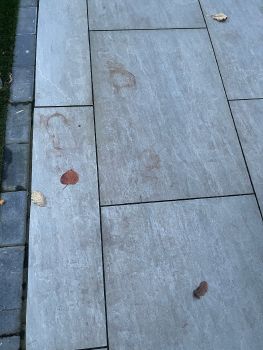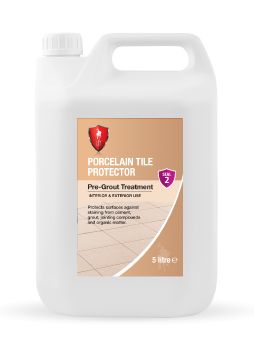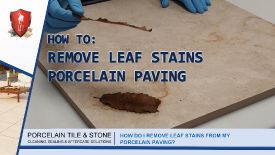
Have you come across dark coloured leaf prints or stains on the surfaces of porcelain tiles? If so, the chances are that these marks could be caused by tannins. Made up of polyphenol compounds, tannins are naturally found in plants and trees and, whilst they can cause tile issues, they offer natural protection in lots of different ways.


Tannins are very common in leaves (especially the top surface), roots and heartwood of trees. In each case, they act as a natural preservative and pesticide. Tannins are also found in food and drinks, like tea, coffee and wine, in which they contribute to an astringent taste. That same astringency makes leaves and trees less tasty too, offering protection against herbivores.
Because tannins are water-soluble, their molecules are easily transformable onto other surfaces, like tiled paths and patios. It is this chemical reaction that can create leaf-shaped prints on tiles. Tannin is also corrosive to ferrous metals and can cause blue-black staining if it comes into contact with iron-rich stone. Staining is also common underneath or near wooden garden structures, like pergolas, gazebos and furniture, where tannins wash off the surface of the timber. Oak is particularly rich in tannin or tannin acid. However, in terms of wooden structures, issues can often be avoided if the timber is properly seasoned or primed.
How to remove tannin stains from porcelain tiles
To remove marks caused by leaves and nearby timber structures, we recommend application of LTP Grimex intensive cleaner, diluted 1:3 with warm water, onto the stain. If the staining is particularly prominent, the surface can be agitated with a scrubbing brush or black pad straight after application. The treatment should then be left to react for 5-10 minutes, with more solution added if it starts to dry out. The tiles should be agitated again and the residue wiped away with a sponge or mop. Finally, the tiles should be rinsed with clean water. In extreme cases, neat solution can be used and the same method applied.
To protect porcelain tiles from future tannin staining, we recommend barrier treatment, LTP Porcelain Tile Protector – a non-film forming solution that creates a barrier against moisture and organic matter and makes ongoing maintenance easier. Being water-based, the protector can be applied over some residual moisture. As a rule of thumb, it’s generally safe to apply over the autumn and winter provided that no rain is forecast for 24 hours, either side of application.


For more advice on tile maintenance and protection, please visit http://www.ltp-online.co.uk, contact LTP on tel. 01823 666213 or email [email protected]
ends –
For media information and photography, please contact [email protected]




